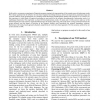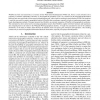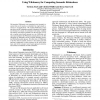119 search results - page 10 / 24 » Using Measures of Semantic Relatedness for Word Sense Disamb... |
LREC
2010
13 years 10 months ago
2010
In this article, we present an experiment of linguistic parameter tuning in the representation of the semantic space of polysemous words. We evaluate quantitatively the influence ...
LREC
2008
13 years 10 months ago
2008
WordNet has been used extensively as a resource for the Word Sense Disambiguation (WSD) task, both as a sense inventory and a repository of semantic relationships. Recently, we in...
LREC
2008
13 years 10 months ago
2008
Word Sense Disambiguation (WSD) is an intermediate task that serves as a means to an end defined by the application in which it is to be used. However, different applications have...
AAAI
2008
13 years 11 months ago
2008
We introduce Wiktionary as an emerging lexical semantic resource that can be used as a substitute for expert-made resources in AI applications. We evaluate Wiktionary on the perva...
BMCBI
2010
13 years 8 months ago
2010
Background: Word sense disambiguation (WSD) algorithms attempt to select the proper sense of ambiguous terms in text. Resources like the UMLS provide a reference thesaurus to be u...



